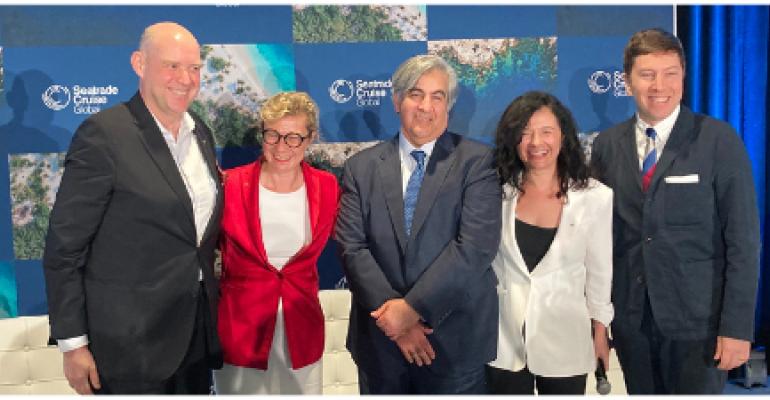Key to that is the destinations, said Silversea Cruises President & CEO Barbara Muckermann during Wednesday's "Luxury Cruising CEO Panel" at Seatrade Cruise Global.
"In the '90s luxury in cruising was defined as standard, so we were looking at the old standards and we were deciding how many seconds the waiter needed to spend before serving the coffee," she said. "That was luxury, having exactly the same luxury experience everywhere you were in the world, which meant you were in India and having a wonderful French dinner served."
The consumer has changed with the silent generation, who she said were very conservative in their tastes, for instance, "wanting their Dunkin’ Donuts coffee everywhere."
Implanting in the destination
"Now we have the boomers. Boomers want to try food from other cultures ... They really want to implant in the destination. This is why today luxury is being in Portugal, and offering an experience ashore with a cheap rosé and sardines, because that is all what is really unique about the food culture and industrial culture of Portugal."
Also on the panel were Explora Journeys CEO Michael Ungerer, Seabourn Cruise Line President Natalya Leahy and Ponant Americas CEO Navin Sawhney.
Leahy added that customers now crave "simple, unpretentious, authentic elegance."
Sawhney said the mindset of their customers has changed from sightseeing, and even changed from "site-doing" so now they want to go so far as cleaning up the site.
Limiting impact
"That's the kind of local immersion they are seeking whether they are on an expedition or whether they are on exploration in a classical area," he said touching on the theme of the conference, which has been sustainability. "They do want to better understand how communities sustain when they visit local areas."
Ungerer hammered home that it's not just about net-zero carbon emissions, noting that limiting the industry's impact on the places they visit has to be woven into all aspects of what the lines do.
"To me it's the new craftsmanship in luxury," he said, and that while not every customer has that front and center on their minds, it's growing among the customers.
"Some guests are willing to pay today. If you have similar products and one is more sustainable than the other they will choose the one over the other," he said. "It's also the notion of mindful and thoughtful decision-making when purchasing because these people, they've seen it all and have been everywhere and can also afford everything, so to them it's also about a personal choice and going really as deep as personal legacy."
Telling the environmental story to new generations
And while the boomers are the ones paying for it now, it's their children that are already steering the decisions, and collectively the cruise industry, so the luxury segment has to get out in front of telling the story of the environmental efforts.
"The stories that we have to tell, and what we actually invest, the billions that we are going to invest, have gone a long way and are exemplary," he said, noting the luxury lines taking on new fuels and technologies as a "lighthouse function to move those things forward."
"The next generation and the Gen Z and the millennials, they are going to tell their parents what to book and what not to book," he said. "So if we don't have a proper plan and robust plan on the way forward, we won't have to worry about these things in the future anymore quite frankly."
Muckermann and her peers agreed that the small ships of their brands were the ideal platform to try the innovation needed across the industry as the world has yet to produce a truly net-zero ship.
The new Silver Nova will have hybrid propulsion and, for zero emissions in port, fuel cells and batteries.
"This is all great and good and fantastic to have the funds and the drive to do it, but it will not happen without the broader help of government," she warned.
It's a plea the lines have been making for a while to governments to ensure their efforts toward net-zero emissions by 2050 are met in kind with supply and infrastructure improvements, such as shore power at ports, which at present is only available at 2% of destinations globally, Muckermann said.
Optimism despite technological uncertainty
From the cruise lines' side at least, there remains optimism about achieving the goal despite technological uncertainty.
"What is going to make a difference is a culture that we are building on board the ships and in our shoreside communities," Leahy said. "Our guests care not only what, but why. Our team members care not only now what they do, but why they do it and how they do it."
She noted as an example how crew members of one Seabourn ship proudly explained their efforts such as the use of biodigesters to break down food waste, and how they should be donating it as fertilizer to nonprofit organizations on land.
"I think that's what will help us find the path to how we are going to get to our goal, is if we all work together," she said. "Every person on board the ship will make it happen."
Copyright © 2024. All rights reserved. Seatrade, a trading name of Informa Markets (UK) Limited.
Add Seatrade Cruise News to your Google News feed.  |

